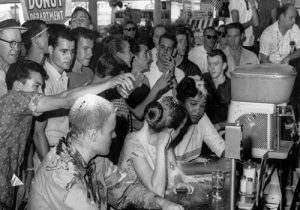8 Methods of Advocacy
Advocacy can include an array of activities, from protesting to letter writing campaigns. More traditionally, advocacy is seen as lobbying to elected officials about an issue or legislation. However, there are many other valuable forms of advocacy/activism that can be performed.
All in all, advocacy means taking up an effort to promote your cause. In general, advocacy-or issue raising- is vital to policy formation: the squeaky wheel gets the oil! Most policy is a result of bottom-up (e.g. grassroots) rather than top-down (e.g. federal mandates) efforts.
Grassroots organizing as a phrase sounds small-scale, but it is how most social transformations and policy begins: a group of dedicated individuals that creates momentum/attention to a cause. The Civil Rights Movement began with grassroots organizing. Yes, REALLY! In fact, civil disobedience and non-violent direct action are key grassroots organizing tactics that were employed then AND now in times of protest and to push forth an agenda.
Non-violent direct action (NVDA) is a popular genre of advocacy and the one espoused by this manual and the author. NVDA encompasses many different tactics, ranging from letter-writing campaigns to protests and sit-ins. American political scientist, Gene Sharp, researched and categorized 198 methods of nonviolent action, see the list at this link: https://www.aeinstein.org/wp-content/uploads/2014/12/198-Methods.pdf.
To learn more about non-violent direct action, its philosophy, and associated historical figures who employed it, visit The King Center’s Glossary of Non-Violence: https://thekingcenter.org/about-tkc/glossary-of-nonviolence/.
At its simplest, it is planned advocacy in which the activist does not act in violent ways in order to convey their message/raise awareness of their issue. However, this does not mean that violence will not take place. For example, non-violent activists protesting segregation during the Civil Rights Movement by sitting in at restaurant counters were often heckled, harassed, and assaulted (see photo below). It is documented that several non-violent activists throughout history- particularly during the Civil Rights Movement- have been arrested, brutalized by law enforcement, raped, and murdered. Being a non-violent activist does not mean that others will not incite or use violence against you.

Alternate Text: College-aged students (white male, white female, and black female) sitting in at Woolworth lunch counter performing non-violent direct action are being heckled by a group of college-aged and older white males. One white male is seen actively dumping food items on the head of the white female activist. The heads of the other activist (white male and black female) are both covered with food items such as ice cream, drinks, and sugar that were dumped on them.

